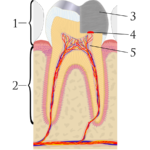
Direct pulp capping is usually indicated in a primary tooth with normal pulp (accidentally) exposed 1 mm or less. A medicament is then applied as a cap before a restoration is placed. The use of direct pulp capping in primary teeth is the subject of debate because of concern over poor success rates.
The aim of this review was to assess the clinical and radiographic success of direct pulp capping in vital primary teeth with either non-cariously exposure or small carious exposure of the pulp tissue.
Methods
Searches were conducted in the PubMed, Embase, Cochrane Library, Dentistry and Oral Science Source, and Google Scholar databases. Only randomised controlled trials (RCTs) comparing different direct pulp capping agents or techniques with at least 6 months follow up and published in English were included. Two reviewers independently selected studies and critically evaluated them using a points-based system. Clinical and radiographic success rates were assessed, and narrative summary presented.
Results
- 12 studies in 573 patients (974 primary teeth) were included.
- Follow up periods ranged from 6 – 24 months.
- 9 studies were considered to be at low risk of bias and 3 at moderate risk.
- 16 different agents were tested including, Calcium hydroxide, formocresol, mineral trioxide aggregate (MTA) , calcium-enriched mixture, simvastatin, 3Mix (a combination of metronidazole, minocycline, and ciprofloxacin), 3Mix plus simvastatin, calcium sulphate hemihydrate , enamel matrix derivative (EMD), etch adhesive (Prime&Bond NT), non- rinse conditioner plus Prime&Bond NT, 36% phosphoric acid plus Prime&Bond NT, a self-adhesive system, calcium silicate cement, resin-modified calcium silicate, and extract from aloe vera (acemannan).
- Clinical and radiographic success rates ranged between 53% (calcium hydroxide) and 100% (MTA and calcium hydroxide).
Conclusions
The authors concluded: –
evidence for the superiority of any material for DPC in primary teeth, in order to preserve the pulp health, was not found. According to the obtained information, and although the proportion of clinical and radiographic failures was low, there is no support to strongly recommend a particular agent over another for DPC in the primary dentition. It appears that calcium hydroxide and adhesive systems, however, demonstrate a higher probability of failure, and formocresol exhibits diverse safety/toxicity/carcinogenicity concerns. Therefore, other safer and more biocompatible agents, such as MTA, calcium- enriched mixture, Emdogain, calcium sulphate, and simvastatin, could be better options for this pulp therapy.
Comments
The topic of pulp treatments in primary teeth was extensively covered in a 2018 Cochrane review led by Smaïl-Faugeron (Dental Elf – 8th June 2018). This new review only focuses on direct pulp capping. It includes all the studies from the earlier Cochrane review adding 3 small studies. None of the studies common to both reviews were rated as being at low risk of bias by the Cochrane team. This is probably because the new review uses a point-based system to assess quality an approach that is not recommended by Cochrane.
The included studies are small and test a large variety of agents with few trials comparing the same agents. This limits the interpretation of the available data as the quality of the evidence as low or very low for all comparisons. Additional high quality well reported trials would be helpful to determine the most effective agents for direct pulp capping in primary teeth. The Cochrane review suggest that trials of MTA, EMD, calcium sulphate hemihydrate and maybe other tricalcium silicates could be helpful.
Links
Primary Paper
Garrocho-Rangel A, Esparza-Villalpando V, Pozos-Guillen A. Outcomes of direct pulp capping in vital primary teeth with cariously and non-cariously exposed pulp: A systematic review [published online ahead of print, 2020 Feb 20]. Int J Paediatr Dent. 2020;10.1111/ipd.12633. doi:10.1111/ipd.12633
Other references
Dental Elf – 8th June 2018
Dental Elf – 10th May 2015
Photo credits
Ian Furst, Goran tek-en / CC BY-SA
